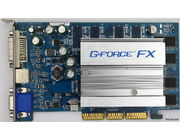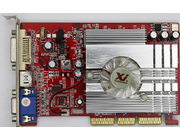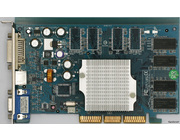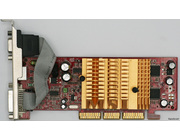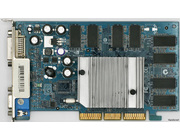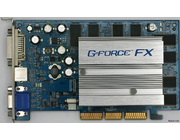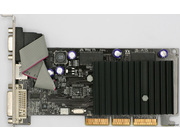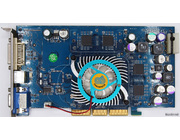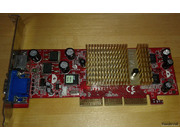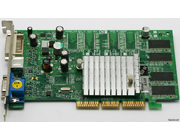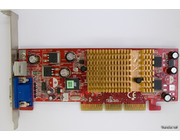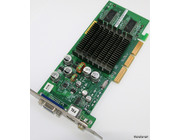This chip is used in the GeForce FX 5200, 5200 Ultra and PCX5300.
Chaintech used to name their products Apogee <modelnumber> for the graphic cards of the GeForce FX and 6-series era. You could also buy Apogee-named motherboards from Chaintech of which some of the higher end motherboards had fancy colors and features.
However this Apogee FX-20 is an exception to that. It's a bog standard 64-bit GeForce FX 5200 with default 250MHz GPU and 200MHz RAM clock frequencies. It's chip date is 14th week of 2003 which makes this card an early one. The GeForce FX was released just a few weeks by then. > Read more
The GeForce FX 5200 was nVidia's entry card of the GeForce FX line-up in 2003. This particular card was made in 2008, however. Still usuable for 2D-work of course but really incapable of doing anything 3D related software of that time-frame. So much for a budget graphics card ... ;-).
This card also has a 64-bit memory bus with only 4 memory chips in total. It saves on PCB costs but again cuts performance. To compare: this card scores 13.1 FPS in 3DMark2001's Nature Demo. A proper FX 5200 (with 128-bit memory bus) scores 18.5 FPS. That's almost half the performance extra. > Read more
A GeForce FX from the time when the GeForce FX was still nVidia's flagship GPU. The 5200 was the low-end card, however. This XFX GeForce FX 5200 performs quite well in 5200-terms: it has a 128-bit memory interface with memory clocked at 166MHz (DDR333). A lot of GeForce FX 5200 cards only have a 64-bit memory bus which cuts performance in half.
The card also has 256MB RAM. It's not the amount that is critical but the fact that 256MB requires the manufacturer to use 8 memory chips that is only possible with a 128-bit memory bus. Some think more RAM is always faster but a FX 5200 really isn't fast enough to work with high-res textures that require 256MB so 128MB is enough. It's the faster bus that matters in this case ![]() . > Read more
. > Read more
Not sure which brand this card is. FX 5200-DV256 looks like an AOpen part number but usually AOpen gives their cards more branding. I also found one reference to 'Apollo' but I'm not sure about that.
Nevertheless; a PCB-date of week01 of 2006. When this card was new in 2003 it wasn't really the star of the show. Let alone in 2006. One can only hope that this card found it's way in a PC suited for Office-work ![]() . > Read more
. > Read more
nVidia released the GeForce FX 5200 Ultra on 6 March 2003, along with the regular 5200, the 5600 (and Ultra) and 5800 (and Ultra).
In technical terms the FX 5200 Ultra is slightly different than the FX 5600, but performance wise they are on pretty much the same level. The 5200 chip has been made on a 150nm manufacturing process instead of 130nm for the 5600 and features like IntelliSample aren't available.
I think it's odd that nVidia released the 5200 Ultra because it is competing with it's own 'brother'; the 5600. Back in the day you would either (and still) buy a GeForce 4 Ti or a GeForce FX 5600 if you wanted to be in the middle performance segment. Probably nVidia quickly saw that the 5200 Ultra was unnecessary because it wasn't for sale for a long time. Along with the FX 5800 Ultra, the FX 5200 Ultra belong to the least common GeForce FX cards. > Read more
A small budget graphics card from MSI. As stated in the story of the MSI FX5500 you can find these small PCB's with FX 5200, FX 5500 and even GeForce4 MX 4000 chips. Because these share the same base (especially the FX 5200 and FX 5500, they are almost identical), they can use the same PCB. This decreases development costs. > Read more
A late GeForce FX 5200 from Leadtek. It comes with the box and has sort of acceptable entry-level performance for early 2003, which is two and a half years late as this card was made in 2005 ![]() . > Read more
. > Read more
The MSI GeForce FX 5500-TD256 can be found in two forms; as MS-8911 and MS-8936. It's based on nVidia's GeForce FX 5500 GPU. Both the GeForce FX 5200 and 5500 are based on the NV34 so you do the math in terms of performance ![]() . Even better; the MS-8911 PCB can be found with both the FX 5200 and the FX 5500 chip and the MS-8936 PCB with the FX 5200, FX 5500 and even the GeForce4 MX 4000!
. Even better; the MS-8911 PCB can be found with both the FX 5200 and the FX 5500 chip and the MS-8936 PCB with the FX 5200, FX 5500 and even the GeForce4 MX 4000!
As companies can configure their card like they want it (in a certain way at least), a lot choose for a 64-bit memory bus on these cards. Just like the GeForce FX 5200 the first benchmarks when the card was released we're often run with cards that featured a 128-bit memory bus. The actual products mostly sold with a 64-bit memory bus. Both in theoretical and practical terms this means 50% performance difference! > Read more
Some low-end products can sell for years and years. nVidia's GeForce FX 5200 is a good example of this. It has been launched in 2003 and has been sold in 2003, 2004 and 2005. Even after a while the GeForce FX 5500 popped up (which is practically a FX 5200; slow too ![]() ) and has been sold in 2005 as well.
) and has been sold in 2005 as well.
Because these cards are cheap to produce and passive cooled they have found their place in many desktop and/or office systems. They are not meant for modern 3D-games but can play 3D-games from several years ago and display 2D office-work. > Read more
